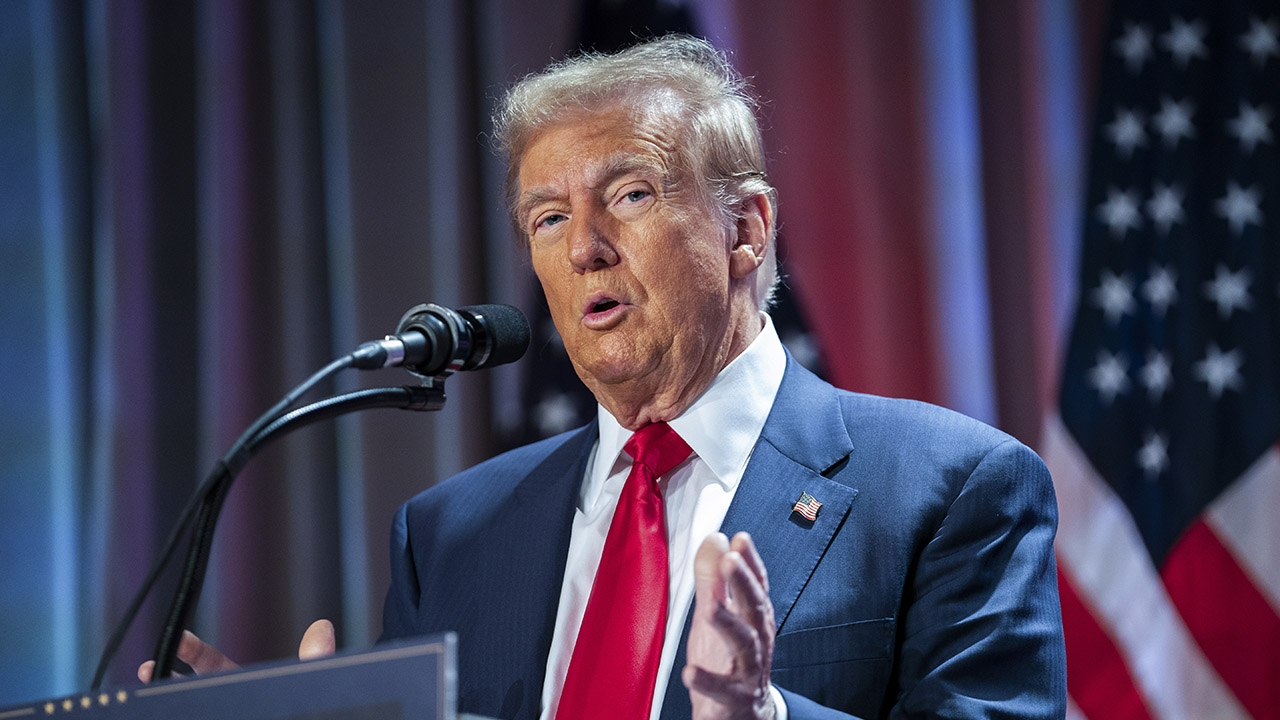President-elect Donald Trump speaks during a meeting with the House GOP conference, Nov. 13, 2024, in Washington. (AP File)

- Trump’s 3-3-3 plan aims to cut the deficit, boost growth, and increase energy output by 2028.
- U.S. shale firms prioritize stability, limiting drilling expansion unless oil prices rise significantly beyond current levels.
- Global competition and market conditions challenge Trump’s energy dominance ambitions, with limited prospects for significant oil and gas output growth.
Share
|
Getting your Trinity Audio player ready...
|
Donald Trump, a man not renowned for the length of his attention span, likes simple formulae. Scott Bessent has one: “3-3-3”. He wants to cut America’s federal budget deficit to 3% of GDP, lift annual economic growth to 3% and increase the country’s oil and gas output by the equivalent of 3m barrels per day (b/d) by 2028, up from 30m in 2024.
The last bit of the plan is the most advanced. Mr. Trump’s administration will open more federal land and offshore blocks to drilling, and approve permits for liquefied natural gas (LNG) projects. Mr. Trump wants to create a National Energy Council that will cut red tape on everything from issuing permits to distribution. And he eyes a bonfire of President Joe Biden’s green subsidies and rules. The goal? Global “energy dominance”, according to the president-elect.
Related Story: Devin Nunes, Pugnacious Trump Loyalist, to Lead Espionage Advisory Board
A petro-boom would advance many of his other aims. More exports would reduce America’s trade deficit. Higher tax takes would bolster its budget. A jump in oil output would allow Uncle Sam to tighten sanctions on Iran at the same time as keeping fuel cheap on forecourts. More American gas would also help to meet rising power demand from artificial intelligence, while reinforcing Europe’s economic reliance on its transatlantic partner. The problem is that Mr. Trump’s wish to “drill, baby, drill” will run up against the hard realities of the energy market. The president-elect is setting himself up to fail.
Unlike in most petrostates, where state-owned companies dominate drilling, in the land of the free oil is pumped by private firms, which are allowed to make their own decisions. They have increased output by a big enough amount since 2022, when Europe started shunning Russian barrels, that America is already the largest producer of crude in the world. In October Uncle Sam cranked out a record 13.5m b/d, up from 11.5m when the Ukraine war began. It is not far off energy dominance already. To go further, America’s oilmen will require a convincing reason.
Related Story: Trump to Announce $100B SoftBank Investment in the US
They may not get one. America’s shale oil, which accounts for most of its output, used to be pumped by thousands of tiny, trigger-happy firms. A wave of mergers and failures since the late 2010s, when overproduction caused prices to plummet, means that the industry is now ruled by a few large companies that hate risk. Their shareholders require stable dividends and double-digit returns. Moreover, dearer capital comes on top of rising costs: as production has surged the best wells have been depleted. Shale firms therefore have little incentive to drill more unless oil prices reach $89 a barrel, according to a survey by the Kansas City Federal Reserve. At $70 a barrel today, West Texas Intermediate (WTI), America’s oil-price benchmark, is far from that threshold.
The market looks unlikely to move in a helpful direction for Mr. Trump. Not only is global oil supply plentiful, but members of the Organization of the Petroleum Exporting Countries (OPEC) have plenty in reserve. At the same time, demand is weak because of tepid global economic growth and the replacement of petrol-powered cars by electric vehicles. JPMorgan Chase, a bank, expects WTI to fall to $64 by end-2025, and to $57 the year after. No wonder the Energy Information Administration (EIA), a federal agency, expects America’s oil output to rise by just 0.6m b/d by 2028. On December 5th Chevron, America’s second-largest energy firm, cut its capital-expenditure forecast for 2025.
Although Mr. Trump will probably roll back taxes on energy firms introduced by Mr. Biden, such as a levy on methane leakages, doing so will mostly benefit smaller drillers, which cause a disproportionate amount of emissions. Michael Haigh of Société Générale, a bank, reckons that cutting taxes for energy firms might bump up output by 200,000 b/d at most. Subsidizing production outright, meanwhile, would be ruinous for the government and cut against another of Mr. Bessent’s objectives: bringing down the budget deficit.
Related Story: The First New Foreign Policy Challenge for Trump Just Became Clear
The incoming administration plans to speed up permits for pipelines. That might make wells with limited market access worth starting, but it is not clear how many such wells exist. With permitting agencies likely to be staffed by novices, projects could flounder, as during Mr. Trump’s first term, when officials cut corners, making permits vulnerable to lawsuits. Some projects collapsed; others were completed billions of dollars over budget. To make more wells viable, Mr. Trump could try to boost oil prices by slapping penalties on anyone buying barrels from Iran or Venezuela, and on those helping them. How long that would work is uncertain, however, as other OPEC members would probably raise production in order to gain market share.
Black mark.
Supersizing gas production looks a little easier — at least on paper. Since Russia invaded Ukraine, America’s pipeline of LNG projects, already long, has lengthened. Rystad Energy, a consultancy, expects the country’s export capacity to reach 22.4bn cubic feet per day in 2030 in the event that Mr. Trump successfully implements his campaign pledges, up from 11.3bn last year—a rise equivalent to 1.9m barrels of oil (mboe) per day in energy terms. What that means in terms of actual output is far from certain. Rystad forecasts it will rise by 2.1 mboe per day by 2028, with some of the increased supplies consumed at home. Others are much less optimistic. Even in its most bullish scenario, the EIA expects production to average just 0.5 mboe per day more that year than in 2024.
For production to truly ramp up, gas prices would have to rise beyond $4.24 per million British thermal units (mbtu), according to producers surveyed by the Kansas City Fed. In reality, these producers expect prices to reach just $3.33 per mbtu in two years (up from around $3 today). Although demand for gas, the least dirty fossil fuel, is set to rise, a lot of new production from Australia, Qatar and others will hit the market during Mr. Trump’s term, restraining price rises. Demand may not exceed supply until the 2030s.
All of this spells trouble for the ambitions of Messrs Trump and Bessent. “How much the US drills over the next few years will depend much more on decisions made in Vienna [where OPEC meets] than in Washington,” says Bob McNally, a former adviser to President George W. Bush. Mr. Trump’s policies could even hurt production. His tariffs might make materials such as aluminium and steel pricier for oil firms. Other countries may retaliate by imposing tariffs on America’s energy exports. And trade wars will sap growth, weakening demand for oil and gas. In the end, Mr. Trump’s ambition to become the ultimate oil baron may be a pipe dream.
—
By The Exonomist
Copyright © The Economist Newspaper Limited, 2024
Syndicated Through The New York Times Licensing
RELATED TOPICS:
Categories

Casanova Is a Lover, True. But He’s Also Loyal and Calm

Tulare Police Warn of Scam Texts Impersonating Detectives

















